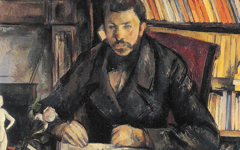Cézanne’s Five Bathers (1885-7)
Today (July 4th, 2012) we published a discovery on our blog by a regular user of the site, Maaike Putman, who recognized a visual illusion in a crucifix by an anonymous craftsman in a Florentine church. It includes in the abdomen of Christ the image of a monk's head and shoulders, thereby suggesting that the artist-monk is Christ. I published it as a blog entry. Do take a look. In light of that discovery I thought I should reveal a similar piece of magic by a great master to demonstrate that these illusions - and the idea that God is inside us - are all over the art of the Western world from the Middle Ages onwards. This aspect of art should, of course, be more widely recognized; perhaps it will be soon.
Even though Cézanne lived at a time when materialist science was in its ascendancy and Charles Darwin's Origin of the Species had overturned the Old Testament view of prehistory, he still believed like Plato and the ancients that truth or wisdom could only be found by looking inwards to unveil the divine essence inside each individual.
It is important to remember when considering compositions by Cézanne that you are viewing a mental image inside his mind. That is why his female nudes are so clunkily constructed; they are mental images of himself as a female nude in the process of becoming. Now consider the painting at left. What else do you see?
Click next thumbnail to continue

Top: Cézanne, Five Bathers (1885-7)
Bottom: Diagram of Christ's head and face within Five Bathers
Click image to enlarge.
Just as earlier artists had portrayed themselves as Christ (as revealed on this site) so did Cézanne. The entire image recalls an archetypal head of Christ with the tree trunks on either side as substitutes for the long, curling locks of Christ's hair. The bottom of the woman crouching in the stream defines Christ's chin but all else is left approximate. Your eyes must imagine the details of Christ's face between the trees from the few pointers he has left us and it is not unusual to be certain that you know where the "eyes" are placed one day, only to find that they have moved the next. They are somewhere near the heads of the two women leaning in towards the middle.
Click next thumbnail to continue
If you have trouble imagining Christ's head within the tree trunks, take a look at Cézanne's massive canvas of Bathers in Philadelphia in which a woman's head is framed again by trees, though with more detailed features on the face itself. Academics refuse to accept the illusion of a girl's head in this canvas. Indeed they poured so much derision on Sidney Geist when he first revealed it that no sensible scholar (God knows, I'm not sensible) would dare suggest it again.
Click next thumbnail to continue
Here, in another of the Bathers series, is a third example, again with a woman's head, her eyes closed as though dreaming.
Click next thumbnail to continue
Cézanne's scenes of women bathing can now be seen as rites of purification inside his androgynous mind where female alter egos are shown "washing away" their egotistical impulses. The stream and nude figures even recall scenes of Christ's baptism in the river by St. John.1 Others have viewed the figures as derivations from Raimondi's celebrated print The Judgment of Paris which, through a pun, the artist imagined as being the judgment of critics at the Paris Salon. The end-result of this process is the artist's complete identification with God and his creative powers. In later years Cézanne did attend Church though with little enthusasm for the priesthood. He knew, as all artists do, that God is inside us.
More Works by Cezanne
Notes:
1. Through reviewing all of Cézanne's scenes of bathers I have come to the conclusion that bathers who point with their fingers "paint" and that a woman whose shoulder (épaule) is touched references the rhyme in his own name in French (Paul). This was first suggested by Sidney Geist. Long locks of hair further suggest the hairs of a paintbrush. See Sidney Geist, Interpreting Cézanne(Harvard University Press) 1988, pp. 149, 188
Original Publication Date on EPPH: 04 Jul 2012. | Updated: 0. © Simon Abrahams. Articles on this site are the copyright of Simon Abrahams. To use copyrighted material in print or other media for purposes beyond 'fair use', you must obtain permission from the copyright owner. Websites may link to this page without permission (please do) but may not reproduce the material on their own site without crediting Simon Abrahams and EPPH.







